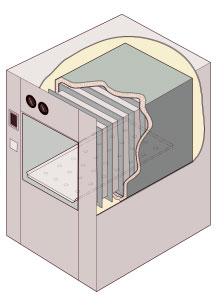Autoclave
(Redirected from Sterilisers)
Autoclave
An autoclave is a device used to carry out industrial and scientific processes requiring elevated temperature and pressure different from ambient air pressure. Autoclaves are used in applications such as sterilization of medical equipment, chemical reactions, and the curing of composites.
History[edit | edit source]
The concept of the autoclave was first developed by Charles Chamberland in 1879. The invention was a significant advancement in the field of microbiology and medicine, allowing for the effective sterilization of surgical instruments and other medical tools.
Principle of Operation[edit | edit source]
Autoclaves operate on the principle of steam under pressure. The basic process involves:
- Loading the items to be sterilized into the autoclave chamber.
- Sealing the chamber and removing air from it.
- Introducing steam into the chamber at high pressure.
- Maintaining the temperature and pressure for a specified period.
- Allowing the chamber to cool and depressurize before opening.
Types of Autoclaves[edit | edit source]
There are several types of autoclaves, including:
- Gravity displacement autoclaves: These use steam to displace air in the chamber.
- Pre-vacuum autoclaves: These remove air from the chamber using a vacuum pump before introducing steam.
- Steam-flush pressure-pulse autoclaves: These use repeated pulses of steam to remove air from the chamber.
Applications[edit | edit source]
Autoclaves are used in various fields, including:
- Medicine: Sterilizing surgical instruments, laboratory equipment, and medical waste.
- Microbiology: Sterilizing culture media and laboratory glassware.
- Dentistry: Sterilizing dental instruments.
- Veterinary medicine: Sterilizing veterinary instruments and equipment.
- Industrial applications: Curing composites, vulcanizing rubber, and processing certain chemicals.
Safety and Maintenance[edit | edit source]
Proper maintenance and safety protocols are essential for the safe operation of autoclaves. Regular inspections, calibration, and adherence to manufacturer guidelines help ensure the autoclave operates effectively and safely.
See Also[edit | edit source]
References[edit | edit source]
External Links[edit | edit source]
Translate: - East Asian
中文,
日本,
한국어,
South Asian
हिन्दी,
தமிழ்,
తెలుగు,
Urdu,
ಕನ್ನಡ,
Southeast Asian
Indonesian,
Vietnamese,
Thai,
မြန်မာဘာသာ,
বাংলা
European
español,
Deutsch,
français,
Greek,
português do Brasil,
polski,
română,
русский,
Nederlands,
norsk,
svenska,
suomi,
Italian
Middle Eastern & African
عربى,
Turkish,
Persian,
Hebrew,
Afrikaans,
isiZulu,
Kiswahili,
Other
Bulgarian,
Hungarian,
Czech,
Swedish,
മലയാളം,
मराठी,
ਪੰਜਾਬੀ,
ગુજરાતી,
Portuguese,
Ukrainian
Navigation: Wellness - Encyclopedia - Health topics - Disease Index - Drugs - World Directory - Gray's Anatomy - Keto diet - Recipes
Search WikiMD
Ad.Tired of being Overweight? Try W8MD's physician weight loss program.
Semaglutide (Ozempic / Wegovy and Tirzepatide (Mounjaro / Zepbound) available.
Advertise on WikiMD
WikiMD is not a substitute for professional medical advice. See full disclaimer.
Credits:Most images are courtesy of Wikimedia commons, and templates Wikipedia, licensed under CC BY SA or similar.Contributors: Bonnu, Prab R. Tumpati, MD




